We took a leisurely morning while most of the troops went off on a walking museum tour of the Agua Clara and Gatun Locks.
Later, we were joined by a new pilot and moved north on the Canal, this time in the lead of a giant freighter.
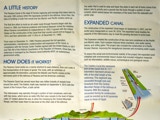
This is some general information about the Panama Canal. For a great illustration of how the new Agua Clara Locks work, see Maps
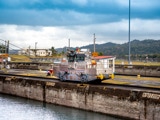
These mules are fascinating. Obviously, back in the earliest days of the Canal, real mules served the same function - to keep ships centered in the lock like a rubber ducky as the bathtub fills or empties. From the photos showing the walls of the Canal, it is obvious that storms, wind, bad captains, bad mules or all of the above have not done that mission perfectly. Today’s mules weigh 50 tons (most of which is the electric motor that propels it) and run on a 5’ track with a center powering cog set below level. Ships control their own forward movement relying on the mules for braking and centering.
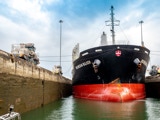
Meet the Indonesian Bulker. This behemoth followed us into and out of all of the locks today. Imagine the skill needed to keep this ship (almost 200’ wide) in the center of this lock with only 2’ of clearance on either side! In the new Canal, the ships are so big that it takes 8 mules to center them.


Small crafts like ours are not centered; rather they are lashed to the side by one of the crew with huge plastic buoys sandwiched between vessel and wall.
The gates on our locks swing out from niches in the wall. On the new Canal, the gates slide out from the walls like pocket doors in a Victorian house.
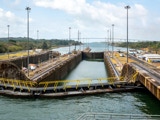
Looking out into our last Gatun Lock. The city of Colon and the Caribbean Ocean lie beyond. Note the walkway for workers to cross the canal on top of this lock. The locks in the new canal are so wide a car can drive across them.
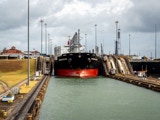
The Bulker joins us in the last lock.
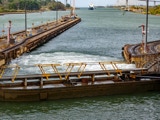
50,000,000 gallons of water have been used to carry us over the mountains of central Panama, all supplied by the Chagres River. There goes all that fresh water out to sea. It seems a waste, however, there is so much rain that water has to be periodically released from Lake Gatun. Nonetheless, the new Canal recycles the water for the locks using pumps.

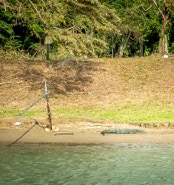
Detail of the track used for the mules.
A rather large crocodile seems unimpressed by all this technology.
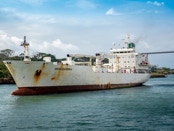
It’s a 24-hour operation. This ship waits for us, the last two ships to leave the north transit of the Canal today, so they can reverse the process and send another batch of ships south.
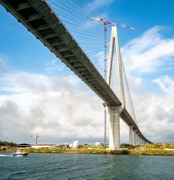
Did I not tell you Panama has some mighty handsome bridgework?
Our berth for tonight was in an old U.S. military base called Shelter Bay. Now, it is a beautiful marina where we paused to raise a glass of wine, tour the surroundings and get ready for our Farewell Dinner tonight.